Stretching across 63 provinces,each historical monument is a witness of time,preserving heroic stories and cultural beauty of the nation. Typical historical relics of each province in 63 provinces of Vietnam - Part 3 continue the journey to discover places with historical imprints,help us better understand the past and respect the traditional values. Following,63stravel learn more about the typical historical sites of the remaining provinces!
Good article on the same topic: Typical historical relics of each province in 63 provinces in Vietnam - Part 1 Typical historical relics of each province in 63 provinces in Vietnam - Part 1 Top 20+ Southern resorts should definitely go 1 time The most beautiful phượt roads in Vietnam are for the movement
Typical historical relics of each province in 63 provinces in Vietnam - P3
Each land on the S -shaped strip of land preserves heroic memories through historical sites. "Typical historical relics of each province in 63 provinces of Vietnam - P3" will continue to take you to discover those meaningful time marks!
Ancient rock stream Van Van - Gia Lai
Address: in the town of Ialy,Chu Pah district,Gia Lai province
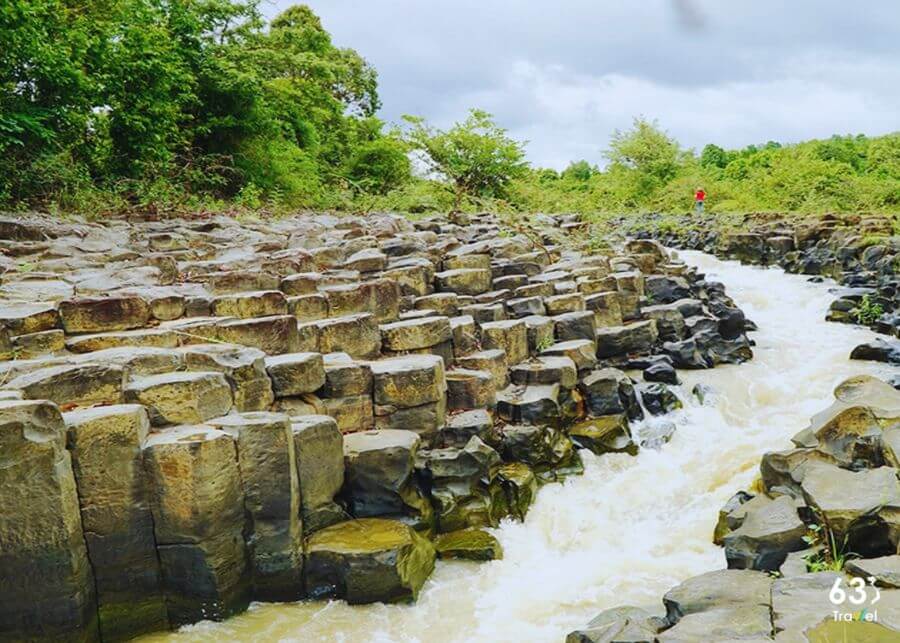
The ancient rock stream Van Van has a magnificent and taciturn beauty as a natural masterpiece in the heart of the Central Highlands. The stacks of Luc Lang stacked on top of each other stretching on both sides of the murmuring stream,creating a wild and mysterious scene.
At this point,visitors not only immerse themselves in the peaceful space of the mountains but also feel the intersection between nature and human life. Amid the immense green of the plants,the sound of water flowing through the rocks as a gentle music of the great thousand,taking us away from the noise of the city to find peace in the soul.
Buon Ma Thuot - Dak Lak house
Address: No. 18 Dien Thuat,Tu An Ward,Buon Ma Thuot City,Dak Lak Province
Ticket price: 20,000 - 30,000 VND/ person.
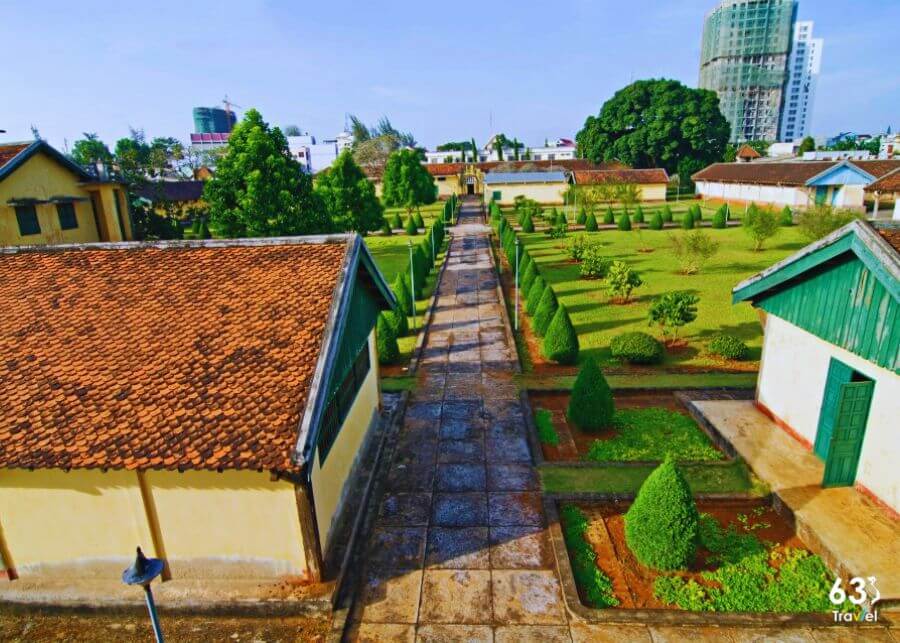
Buon Ma Thuot exile (also known as Pénitencier de Ban Me Thuot) is a historical evidence marking the years of resilient struggle of the Vietnamese nation. Located in the heart of Buon Ma Thuot city,this place is not only a special national historical monument but also an important "red address",reminiscent of the indomitable spirit of revolutionary soldiers.
With a solid U -shaped architecture,a system of isolated and strict cell towers,the exile used to be a place to imprison and torture many elite soldiers such as Vo Chi Cong,Phan Dang Luu,Ho Tung Mau,Nguyen Chi Thanh,To Huu ... but despite being clamped in the shackles,their will to struggle has never shaken. Today,the exile is preserved as a historical museum,where the exhibits of artifacts and images recreate the crimes of the colonialists,and deepening the lesson about the patriotism and the faithful spirit of his father. I.
Dak Mil Hell - Dak Nong
Address: Village 9,Dak Lao Commune,Dak Mil District,Dak Nong Province
Hide in the middle of the old forest in Village 9,Dak Lao Commune,Dak Mil District,Dak Mil Prison is a painful historical but also proud historical evidence. Built by the French colonialists in 1940,it became a "hell on earth" to detain the permanent communist soldiers from Buon Ma Thuot's exile.
Under the brutal imprisonment regime,the revolutionary prisoners still did not subdue but also established the first communist branch in the M'Nong plateau,organized two bold prisoners,stirred up the tendency to fight painting. The prison is built from wooden walls,paintings,surrounded by barbed wire fences,inside are cramped wooden floors,feet shackles,hand shackles,symbolizing the harshness of the colonial regime.
But despite being imprisoned,revolutionary will still boil,demonstrating that violence could not subdue patriotism. In 2005,the Dak Mil prison was ranked national historical monuments,becoming a symbol of the spirit of resilience and the desire to freedom.
Dinh Bao Dai 1 - Lam Dong
Address: No. 1 Tran Quang Dieu,Ward 10,Da Lat City,Lam Dong Province.
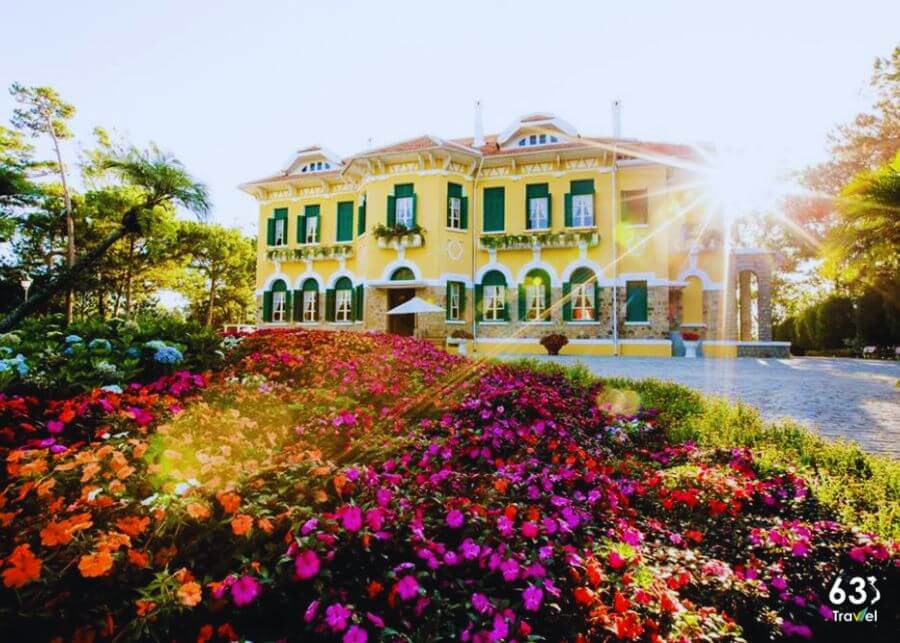
Located in the middle of 18 -hectare pine forest in Dalat,Dinh 1 Bao Dai is not only a beautiful architectural work but also has a historic imprint. Initially,this mansion was built in 1940 by French millionaire Robert Cléger Bourgery. In 1949,the father -in -law of King Bao Dai contributed money for him to buy and turn this place into a headquarters,where the king worked in the years to hold the position of the Father (1949 - 1954).
The classic European style,prominent with the ancient cajuput,leading the entrance to the main gate,the bright flower garden,luxurious fountains and large campuses,ideal for walking and checking-in. The inner space is delicately decorated with the meeting rooms,bedrooms of King Bao Dai,Queen Nam Phuong and Mrs. Tu Cung,each room is associated with attractive historical stories. In particular,this place also has a secret tunnel designed cleverly right inside the king's bedroom,leading to the helicopter background behind the palace.
Experiencing many ups and downs of history,Palace 1 was a resort of heads of state before 1975. By 2014,the local authorities conducted remodeling and opened for visitors to visit and explore. Today,Palace 1 is not only an attractive destination in Da Lat but also a witness of important historical periods,bringing visitors back time to feel the past breath in the middle of the poetic scenery of Lam Vien Plateau.
Victory place to block the ship O - Binh Phuoc
Address: Hamlet 4,Tan Khai Commune,Hon Quan District,Binh Phuoc Province.
If you are looking for a destination with a historic imprint,where the heroic history of the nation,the victory relic of the O O O blocker is definitely the option not to be missed. Along with the Ta Thiet base area,this place is a vivid evidence of the resilient fighting spirit of our army and people during the years of resistance against the US full of hard but majestic.
The name of the ship is attached to the stream of the same name flowing through Highway 13,in Tan Khai commune. In the Nguyen Hue campaign in 1972,this is an important position arranged by the 7th Division to cut off the enemy's reinforcements from Saigon to Loc Ninh. For many days,our troops were resiliently clinging to,repelling a series of fierce attacks with bombs and modern weapons of the enemy. The courage and conspiracy of the soldiers made a resounding victory,making an important contribution to the cause of the liberation of the South.
In 2009,the monument was built on an area of more than 11,000m²,including a memorial stele and a victory monument,becoming a sacred destination for today's generation to remember the merits of those who fell because of poison. national founding. In 2012,this place was officially recognized as a national historical monument,attracting a large number of tourists,especially those who love history.
Although it is not a place that has a magnificent beauty to "live virtual," but the victory relic of the O O Cam is still strong enough to hold anyone with deep historical values. Coming here,you will be resurrected by your father's resilient battle years,to be more proud and appreciate today.
Ancient Tower of Mac - Tay Ninh
Address: New Hamlet,Tan Phong Commune,Tan Bien District,Tay Ninh Province.
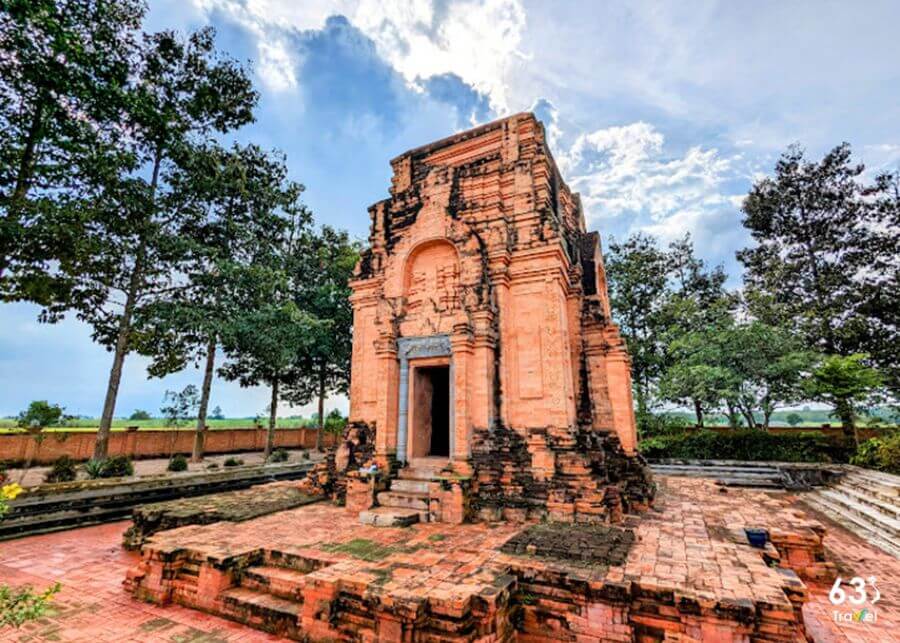
Top Tower (or Last) is one of the few remaining works of Eo culture in the South,demonstrating a flourishing period of the Funan Kingdom. Built in the eighth century,in the Oc Eo period,the tower is located on a high mound of the new hamlet,Tan Phong commune,Tan Bien district,Tay Ninh province. By the middle of the nineteenth century,French archaeologists discovered this monument,although at that time,the tower was heavily destroyed by harsh time and nature.
The name "tip" stemming from the tip of the tower was lost when detected. Despite many restoration,up to now,the tip has not been fully restored. The tower has a square structure with a 5m long bottom,about 10m high,only one door is facing east. The foot of the tower consists of three floors overlapping,smaller to the top,showing the typical architectural style of Eo culture. In particular,this project is built by the method of stacking stones and baked bricks without using adhesive,reflecting the skillful technical level of the ancients.
Not only has the architectural value,Top Mac tower is also an important evidence of the religious life of Oc Eo residents. Archaeologists have found here the Yoni altar and the Vishnu statue with sandstone dating back to the eighth century,suggestive to a temple of Vishnu has collapsed,while the other tower can be the place to worship. Shiva god. Along with the ancient tower of Binh Thanh,Top Mac tower is a valuable impression on a brilliant development period,which was ranked by the Ministry of Culture,Sports and Tourism in the national historical and cultural relics in 1993.
Although not as intact as in the beginning,the Top Tower still carries in itself the great historical and cultural values. At this point,you not only admire the unique architectural work but also have the opportunity to explore mysterious stories about an ancient civilization that has developed brilliantly on the Southern land.
Di An - Binh Duong communal house
Address: KP. Nhi Dong 1,P.Do An,Town,Do An,Binh Duong Province
Di An communal house,also known as Di An communal house,is located in KP. Nhi Dong 1,P. Di An,Di An Town,Binh Duong Province. Initially,the suspension was a simple hut for residents to worship spirituality,but over time,this place became a solid spiritual fulcrum,associated with many ups and downs of history,especially in the period. resistance.
Experiencing many restoration,Dinh Di An today is more spacious but still retains the ancient and solemn appearance. The communal house bears the impression of the architecture of Nam Bo village with Tam Quan gate,one main door,two auxiliary gates,decorated with Han Nom characters.
Located on a large campus,shady trees,communal house is not only a place of worship but also a cultural and historical symbol of this land. In the midst of modern life,Di An communal house still preserves the old beauty,bringing a sense of peace and tranquility to many generations of people.
Historical relics of Tan Hiep - Dong Nai
Address: Quarter 6,Tan Tien Ward,TP. Bien Hoa,Dong Nai province.
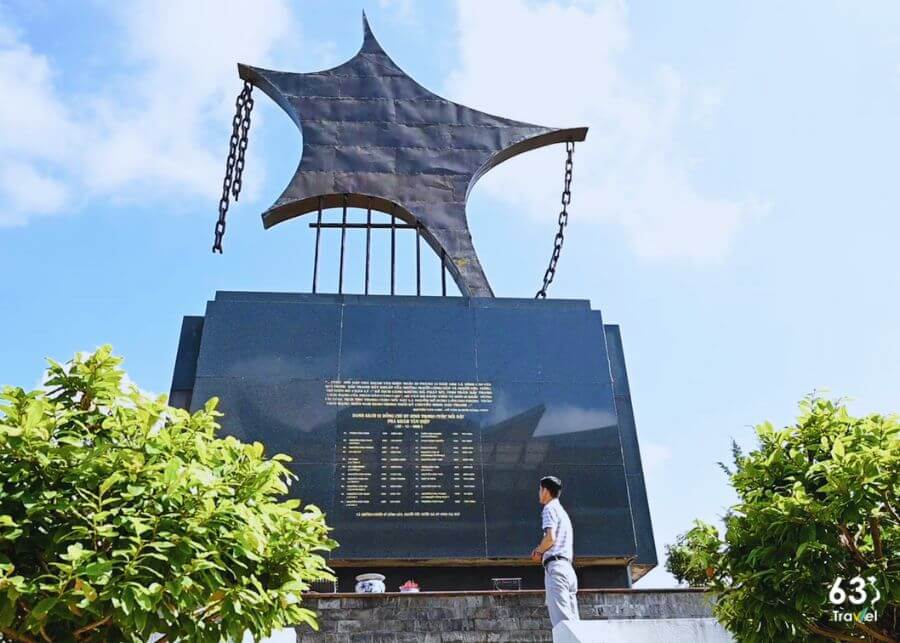
Tan Hiep Prison was once one of the six largest prisons in South Vietnam and the largest prison in the Southeast. Built in a strategic position in the northeast of Bien Hoa town,this place is not only isle but also convenient for the detention,torture and transferring prisoners to Con Dao and Phu Quoc.
The prison is 46,520m² with 8 detention areas,surrounded by 4 layers of barbed wire,9 bunkers,3 watchtowers and modern alarm systems. In the name of the "training center",the prison is actually a hell on earth with guns,torture rooms and harsh forms of exile. Prisoners were locked in cramped rooms,so deprived. Bad diet,rancid food,oil instead of cooking oil makes many people sick and exhausted.
But in that dark place,the fighting spirit was still not extinguished. On December 2,1956,under the leadership of Comrade Nguyen Trong (Seven Tam),nearly 500 revolutionary soldiers and patriotic people bravely destroyed the prison,blowing strongly into the American-Diem regime. Despite being strictly hunted,the majority of prisoners escaped thanks to the protection of the people and became the core of the Dong Khoi movement later.
Today,in order to remember the crime of the enemy and honor the indomitable spirit of those who have fallen,Dong Nai Museum has recreated the event through the image,artifacts and model of Sa Ban. The Tan Hiep Prison is not only an important historical monument but also a red address,a place of revolutionary traditional education for the next generation.
The revolutionary historical site of Con Dao prison - Ba Ria Vung Tau
Address: Nguyen Chi Thanh Street,Con Dao District,Ba Ria - Vung Tau Province
Dubbed the "earthly hell",Con Dao prison is a place to engrave the brutal crimes of colonialists,the empire and the spirit of faithful and indomitable spirit of Vietnamese patriots through two resistance wars. Anti -French and American. Today,this place has become a special historical monument,helping the next generation better understand the great sacrifices of his father for the national independence.
Con Dao Prison was built by the French colonialists on November 28,1861,just four months after they set foot in our country. Initially,this was the detention of political prisoners,but gradually,it became the harshest prison in Indochina. The cramped cells,barbaric tortures and bad living conditions have turned this place into a difficult place to go.
After the Nam Ky uprising in 1940,the number of prisoners here increased sharply,sometimes up to thousands of people. In just two years 1941 - 1942,more than 20 prisoners died in the form of brutal torture. Despite being tormented,the revolutionary will never be subdued. After the August Revolution in 1945,the political prison in Con Dao had risen to the uprising,regained its ownership and returned to the mainland to continue fighting.
When the Saigon government took over Con Dao,the harshness at the prison increased,the peak was the period 1970 - 1972,when nearly 10,000 people were detained in horrific "tiger cages". But despite fierce suppression,revolutionary soldiers still struggle. On May 1,1975,it was the prisoners here rebelled,liberated Con Dao,closed the painful but heroic history.
Today,Con Dao prison is not only a historical place but also a symbol of patriotism. The monument system includes Phu Hai,Phu Tuong,Phu Binh camp (Con Dao tiger cages),Hang Duong Cemetery,914 Bridge,Ma Thien Lanh Bridge ... have become sacred places,where people and people and people Visitors look for gratitude to those who have fallen for independence and freedom of the Fatherland.
Nha Rong wharf - Ho Chi Minh Museum (Ho Chi Minh City Branch)
Address: No. 01 Nguyen Tat Thanh,Ward 12,District 4
Ticket price: 20,000 VND/person
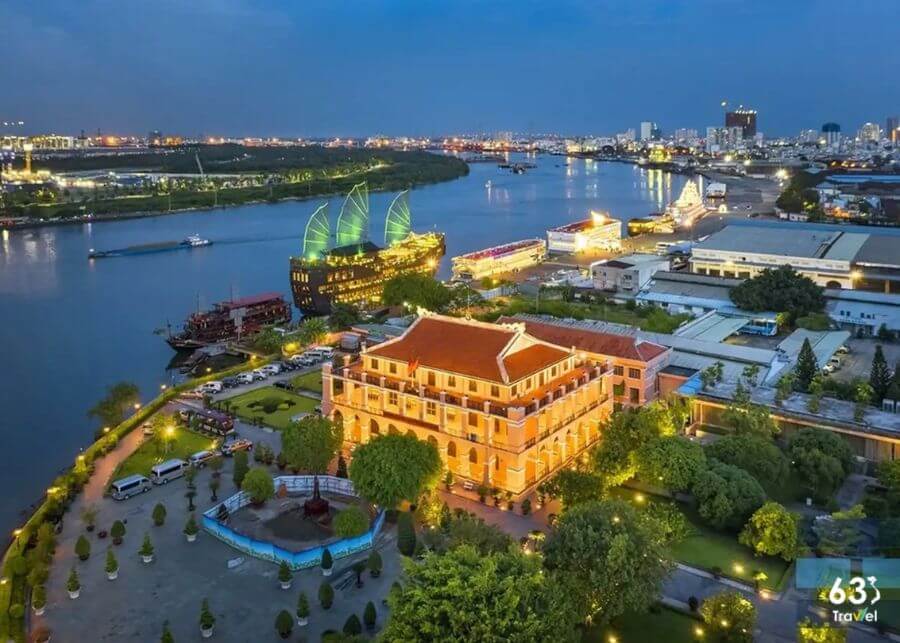
Located on the Saigon River,Nha Rong wharf is not only an important historical monument but also a symbol of Ho Chi Minh City. It was here,on June 5,1911,President Ho Chi Minh took the Amiral Latouche Tréville train,starting the journey to find a way to save the country,opening a new page for the Vietnamese people.
Built in 1863 under the French colonial period,Nha Rong wharf bearing the Asian architectural mark with the image of "Mesopotamia of the Moon" on the roof. Today,this place is the Ho Chi Minh Museum,displaying many valuable artifacts and documents about Uncle Ho's life and career. With solemn space,rich in historical values,Nha Rong wharf becomes a sacred destination,reminding of a heroic period of the nation.
POST PAGE - LONG AN
Address: Trung hamlet,Long Huu Dong,Can Duoc,Long An province.
Hundred columns are not only an old house but also a masterpiece of art with a historical and cultural impression. Built from 1901 to 1903 by Mr. Tran Van Hoa and 15 Hue artisans,the project takes 5 years to complete,from building to sophisticated carvings. Despite the fact that there are 120 columns,the house is still called a "hundred -column house" as a way to call rustic and close.
With an area of 882m²,surrounded by a green garden of more than 4,000m²,a hundred -column house features Hue field architecture and elaborate carved lines on precious wood such as red wood,honey wood. Each pattern motifs on the rafters,couplets and diaphragm reflect the quintessence of Vietnamese sculptures. Not only is the family's living place,the hundred column house is also a historical witness,recognized by the Ministry of Culture and Information as a historical and cultural monument in 1997.
Entering this space,visitors seem to be lost in a nostalgic world,where each wooden item,each diaphragm,and sentence carries the breath of time. If you love the ancient architecture,history and traditional culture,the hundred column house is definitely a destination not to be missed when visiting Long An.
Royal Mausoleum - Tien Giang
Address: Giong Son Quy (Go Rua),Hoang Gia hamlet,Long Hung commune,Tien Giang province
Under the shadow of the great porcelain tree,the royal tomb relics in Go Cong appeared as a quiet but solemn evidence of history. This is the resting place of Duc Quoc Cong Pham Dang Hung - the grandfather of King Tu Duc,a prominent talent of Nguyen.
Built from the beginning of the nineteenth century in Giong Quy Quy,the project was not only a deep spiritual value but also a traditional architectural masterpiece with sophisticated carvings. The mausoleum is surrounded in a spacious and airy campus,with the four -patterns of the four spirituality,the four -quarter is elaborately portrayed.
The most special thing is that the mausoleum is made entirely of precious wood according to the method of chiseling the joints without using a nail. All have created a harmonious overall between solemn beauty and simplicity,simple,bringing visitors back to a golden age of royal architectural art.
Special National Monuments Dong Khoi Ben Tre
Address: Dinh Thuy commune in Mo Cay Nam district,Ben Tre province.
Dong Khoi Khoi Ben Tre relics is one of the important historical sites associated with the Dong Khoi movement in 1960 - the event marking a big turning point in the resistance war against the US. It was here that the first gunfire resounded,opening the strong wave of rebellion of the army and the people of the South.
Today,the monument is not only a place to store images and artifacts about the heroic struggle movement of the people of Ben Tre but also a meaningful destination,contributing to the revolutionary traditional education for the younger generation. . Recognized as a special national historical monument in 1993,the monument includes two main locations: traditional houses and snake communal houses.
Traditional house,inaugurated in 2000,is the most prominent work with an area of over 5,000 m²,built on the former provincial headquarters. The 12m -high Dong Khoi torch on the roof of the traditional house is a proud symbol,symbolizing the spirit of the people of Ben Tre. Inside,the display space recreates the aerobic struggle of our army and people,from rudimentary weapons such as coconut,areca nose,and self -created bombs and borders to the resounding battles that make the enemy terrified scared.
Besides,the relic area also has a granite victory stele higher than 3m,engraved the words "Mr. Dung Dong Khoi,winning the US",as a powerful evidence of the indomitable spirit of the people of the country coconut. With vivid historical space and sacred values,Dong Khoi Khoi Ben Tre relic is a destination not to be missed for those who want to learn about a heroic period of the nation.
Mother's Pagoda - Tra Vinh
Address: Le Loi Street,Ward 1,Tra Vinh City.
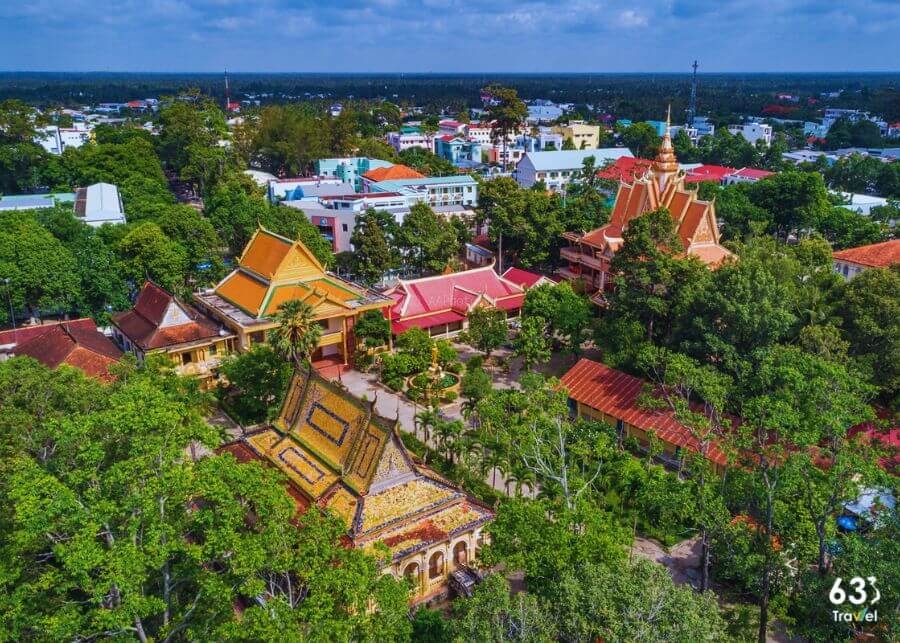
Mother's temple,the most ancient Khmer pagoda,is a sacred symbol associated with the history and culture of the Southern Khmer people. According to Venerable Thach Oai,Permanent Vice Chairman of the Patriotic Council of Tra Vinh Province,the pagoda was recorded in the history of the oldest temple in the area,established in 642.
Located in the heart of the city,Mr.T's pagoda is not only a place of worship but also an important Khmer Buddhist center of Tra Vinh province. Previously,the pagoda was called Wat Kompong - "Ben Pagoda",due to the location near the busy boats and canals. Later,the pagoda was named Bodhisàlaraja,combined from Bodhi (Enlightenment),bàla (the sacred tree of the Khmer),and Raja (king),meaning symbolizing the longevity of Khmer culture.
Owning an area of 12,700 m²,the pagoda features a traditional Khmer architecture,especially the temple gate - a work of artistic carved art with the image of a smile -smiling bird,welcoming guests and a pair of seven -headed snakes The symbol of the Naga protection god. The majestic main hall with 32 precious wooden pillars painted with gold,the roof is like a dragon winding in the air. Shakyamuni Buddha statue 4.4m,5m long,4.3m wide,is one of the biggest statues at Khmer temples in Tra Vinh.
Not only has the spiritual value,the pagoda is also the cradle of education and training for many generations of monks,including reputable monks such as Monk Son Vong,Maha Son Thong,Venerable Maha Thach Sa sieve. In the period of fighting against the French colonialists,the pagoda was the place where the movement was started to claim the right to teach and learn Khmer,contributing to protecting the national cultural identity. With these important contributions,the pagoda of Mother Mother has been recognized as a national historical and cultural relic,becoming a destination not to be missed when exploring the traditional Tra Vinh land.
Professor memorial area,actress Tran Dai Nghia -Vinh Long
Address: Tuong Loc Commune,Tam Binh District,Vinh Long Province
The souvenir area of the professor,actress Tran Dai Nghia is a cultural work with special significance,started on November 24,2013 on the 100th anniversary of his birth. Located in Vinh Long province,this place not only honors the great contributions of the talented professor but also inspires the spirit of studiousness,patriotism and the will to rise to the younger generation. If you have the opportunity to visit Vinh Long,do not forget to stop at this meaningful location.
With an area of about 16,000m²,the memorial area is planned into many important items such as memorial houses,display areas,conference rooms,electronic libraries,traditional living areas and large squares. The space here is designed in harmony with nature,lots of shady trees,bringing relaxation and peace. In particular,the display area preserves more than 868 valuable documents and artifacts about the life and career of Professor Tran Dai Nghia,including books,scientific research,and weapons that he spends even Life for manufacturing for resistance.
A prominent highlight in the memorial area is the electronic library that applies modern technology,helping visitors easily access information about the respectable professor. In addition,the hall can accommodate 200 people and large squares can welcome about 1,000 people,suitable for organizing meetings,exchanges and historical education.
Go Thap - Dong Thap relic area
Address: Two communes My Hoa,Tan Kieu in Thap Muoi District,Dong Thap Province
Go Thap Relics Area,located in My Hoa and Tan Kieu communes,Thap Muoi district,Dong Thap province,is a place bearing an archaeological,cultural and historical impression. Recognized as a national monument since 1998,this place not only preserves long -standing cultural values but also reflects important development stages of the Vietnamese nation and human civilization.
With more than 1,500 years of history,Go Thap used to be an important center of the ancient Funan kingdom,leaving many architectural traces,beer and valuable artifacts. Not only that,this place also marks the glorious feats in the two wars against France and the United States,recreating the heroic history of the nation. In addition to historical values,Go Thap also owns the typical landscape of Dong Thap Muoi area with the interlaced canal system,large ecological forest and rich flora and fauna.
Archaeologists from the 19th century to now have shed many mysteries about the Oc Eo civilization,with a series of important findings such as temples,idols,stele and valuable antiques. Currently,the relic area consists of many typical works such as Minh Su,Sun Spirit,Vishnu Temple and Go Thap Pond,each with a special impression on history and belief.
Ba Chuc's tomb - An Giang
Address: Ba Chuc town,Tri Ton district,An Giang province.
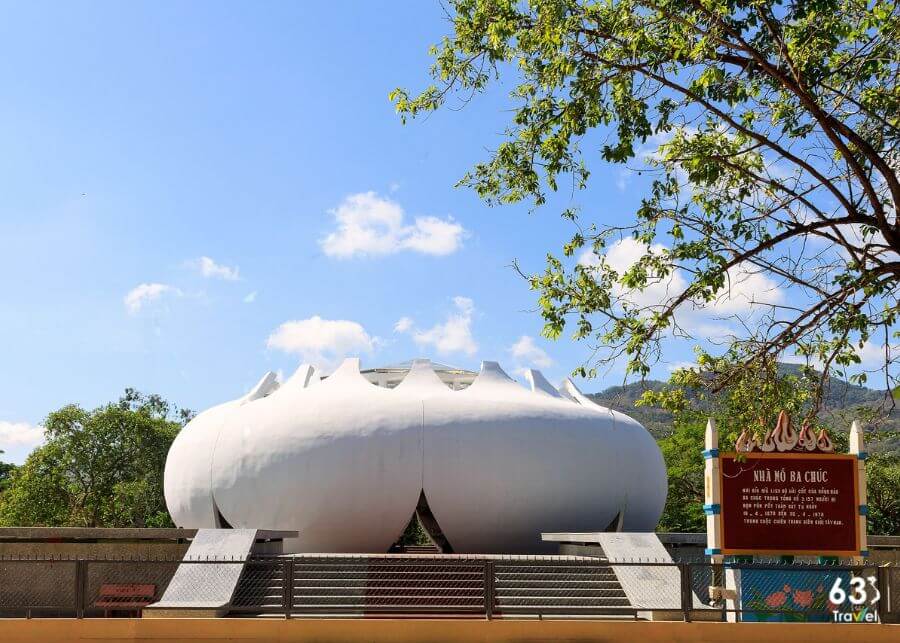
Under the sky of An Giang,the land of paint is famous for its spiritual relics such as Ba Chua Mieu Xu Sam Mountain,Nguyen Huu Canh Temple or Oc Ba The relic area,there is a place that makes people's hearts quiet When visiting - the tomb of Ba Chuc. Located in Ba Chuc town,Tri Ton district,this place marks one of the most painful memories of the southwest border war,when more than 3,000 innocent civilians have been massacre within two weeks from 18/18 4 to 30/4/1978.
Ba Chuc's tomb is not only a accumulation of the barbaric genocide of the Red Khmer but also a symbol of righteousness and humanity. Initially,the building was built in 1979 with hexagonal architecture and the image of four arms clenched in four swords to the ground - symbolizing the indignation and resilient will of the nation. In 2013,the tomb was expanded on an area of 5 hectares,including the display area,the memorial house and the two temples of Tam Buu,Phi Lai. In particular,the grave block bears the shape of a lotus flower upside down with eight white wings,each wing preserves the remains of the victims of different ages,deeply engraved with historical pain.
Entering the display area,each black and white photo,each caption,each artifact such as piles,knives,hammer ... all truly reproduced the crime of war. The quiet space with incense smoke is as comforted as the unjust souls. If you have the opportunity to come to An Giang,take some time to visit Ba Chuc tomb - where not only marks historical tragedy but also reminds us of the value of peace and kindness.
Phu Dung ancient self - Kien Giang
Address: Binh San Ward,Ha Tien,Kien Giang Province.
Nestled at the foot of Binh San mountain,Phu Dung pagoda (also known as Phu Cu Pagoda) is one of the most prominent ancient people in Ha Tien. Not only has the pure beauty between the charming scenery,the temple also contains emotional anecdotes,making many visitors unable to recover when visiting.
Phu Dung Pagoda has an ancient architectural impression with elegant,harmonious lines with nature. Right from the temple yard,visitors can admire the statue of Quan The Am about 4 meters high,solemnly painted white paint. Inside the main hall,the statue of Shakyamuni Buddha was peaceful in the center,the two sides were Anan and Ca Lettuce disciples,and four brilliant reliefs recreating important milestones in the Buddha's life.
Behind the main hall is a two -storey "Jade Emperor" building,where the Jade Emperor worships and the two South Cao and Bac Dau. In particular,a small path on the left of the pagoda leading the entrance to the ancient tomb leaning back into the cliff - the resting place of Mrs. Phu Dung,the character associated with the sad anecdote of the temple. Not only is the sacred spiritual place,Phu Dung Pagoda is also a destination not to be missed for those who love the history and nostalgic beauty of Ha Tien.
The valedictorian memorial area Bui Huu Nghia - Can Tho
Address: Binh Thuy District,Can Tho City
The tomb of the poet Bui Huu Nghia is a solemn project,marking the life of the patriotic artist,the pioneer of the Vietnamese stage and is honored as one of the "four masterpieces" of the South. The tomb area is 10,000m²,including three main buildings: the church in the center,the gallery on the left and the guest house on the right,and the beer house at the entrance. Tam Quan gate with green tile roof,fish pattern and phoenix flying to create an ancient and solemn feature.
Inside,the statue of Bui Huu Nghia was sedated on the altar,the two sides were a pair of cranes showing respect. The tomb was originally built of laterite since 1872 but has been degraded over time.
In 1974,the project was restored,becoming a destination not only with historical value but also a place where people gathered on the occasion of the annual death anniversary. If you have the opportunity to visit,do not forget to explore Can Tho cuisine with typical delicious dishes such as dried shrimp noodles or grilled snails.
Victory relics Vam Cai Sinh - Hau Giang
Address: Ward 7,TP. Vi Thanh,Hau Giang province
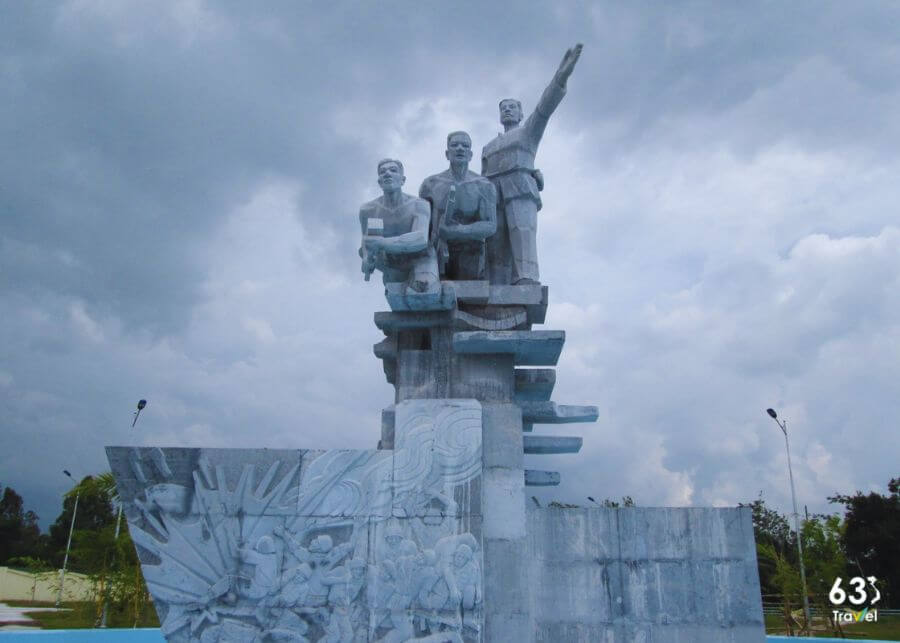
Victory Vam Cai Sinh is an important historical place to mark the resounding victory of our people in the resistance war against the French. This is the place where historical ships took place on December 22,1952,when our troops with smart tactics destroyed nearly 400 enemy soldiers,sinking warships and defeating the sweeping plan of the French colonialists. into the area of Long My - Vi Thanh base.
This victory not only contributes to the consumption of enemy forces but also creates the position and force for the national resistance war,towards the famous Dien Bien Phu victory in 1954. In order to remember this feat,the relic area was attributed to attributed to Planning,building beer to celebrate in 1990 and officially ranked national monuments in 2007. At this point,visitors not only have the opportunity to learn about heroic history but also feel the spirit of Kien Kien Cuong,indomitable of the army and the people of Hau Giang in the years of resistance hardship.
Historical relics of the Victory of Nga Nam - Soc Trang
Address: Ward 1,Nga Nam Town,Soc Trang Province.
The victory relics of Nga Nam branch is one of the eight national monuments of Soc Trang province,located right on the Floating Market Nga Nam,where the heroic history of our army and people in the resistance war against the US. Due to the important strategic location,the US - Wei has built a senior area of a solid military base,but with the spirit of resilient fighting,our army and people organized many attacks,including the battle. In 1968,it lasted for 52 days and nights,defeating this base completely.
Today,the monument is not only a symbol of indomitable will but also a revolutionary traditional education destination. The monument of victory,with the image of the stubborn soldiers,the same square and the large campus,creating a solemn space,reminiscent of a glorious time. Together with Uncle Ho's Temple Cu Lao Dung,this is an ideal destination for the journey to find the historical origin of Soc Trang.
Music memorial area of Cao Van Lau - Bac Lieu
Address: Hamlet 4,Ward 2,Bac Lieu City,Bac Lieu Province
The arts souvenir area of the Southern Don Ca and musician Cao Van Lau is a destination not to be missed when visiting Bac Lieu. This place not only honors the talented musician - author of the immortal "Da Co Hoai Lang",but also the space to store and promote the art of amateur music - A intangible cultural heritage representative of humanity.
Located in Ward 2,TP. Bac Lieu,a souvenir area of more than 12,500m² is a harmonious combination of architecture and music. Right from the entrance,visitors will be impressed with the Nguyet Cam - the stylized symbol of the pliers,and the stairs with the development of the "Da Co Hoai Lang". Surrounded by green stone musical instruments with the image of paintings,storks,gourds,concave key guitar ... The statue of musician Cao Van Lau is solemnly placed,reminiscent of a life of dedication to national music .
Inside the campus,visitors can visit the valuable exhibition house about the amateur music,the reformed costume of famous artists,and the stage space where the sweet melodies are still stored. . In addition,the OCOP booth here also brings specialties in Bac Lieu,contributing to enriching the experience of visitors.
Not only is a cultural destination,the art of the art of the traditional music of Nam Bo and musician Cao Van Lau is also the pride of the people of Bac Lieu - the past and the present interference in each note.
Ca Mau steel wire house
Address: Le Loi Street,located in Hamlet 3,Ward 2,Ca Mau City.
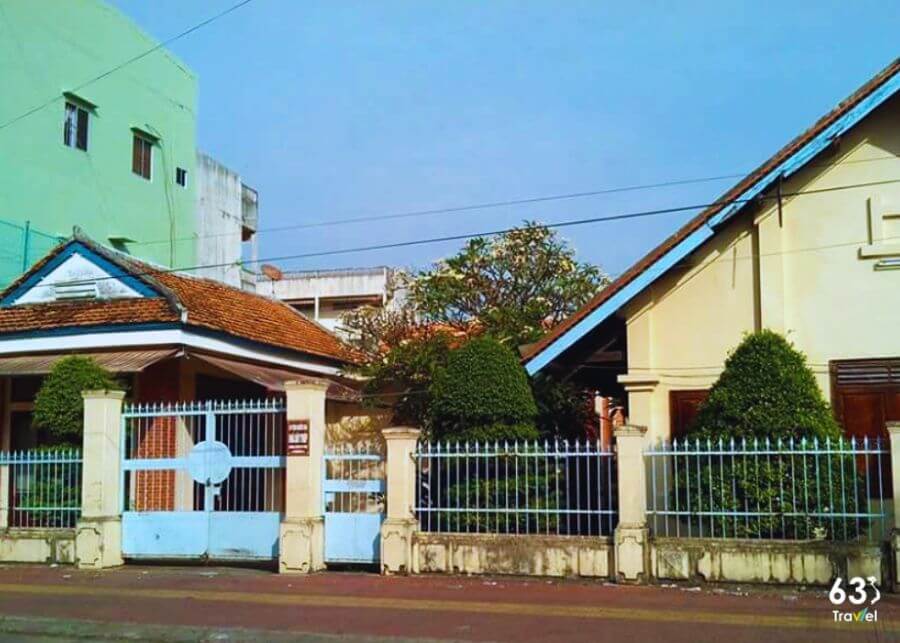
Referring to the glorious victories of the Ca Mau army and people,it is impossible to ignore the important role of steel wire houses - a strategic contact focal point in the resistance war for independence. This national historical monument is located on Le Loi Street,Hamlet 3,Ward 2,Ca Mau City and was recognized as a national monument on June 2,2011. This is not only a historical sight but also a symbol of the resilient struggle of the people of Ca Mau.
For many young people,the name of the steel wire house may be strange,but this is actually a post office built by the French colonialists in 1910,initially serving the purpose of colonial rule and exploitation. However,this place has become an important communication center between the Southern Party Committee and the Ca Mau Party cell during the resistance war. Under the direction of revolutionary soldiers,all instructions and orders were conveyed in time,creating a solid foundation for the struggle movements.
In the 1930s,the communication system in Ca Mau still had many difficulties,but thanks to the skillful use of steel wire houses,the local revolution has had strong development conditions. By the end of 1939,the revolutionary movement here was growing,with the birth of many new cells and organizations such as the Youth Union,the Democratic Women's Union,the craftsmen groups ... In particular,steel wire houses have contributed to connecting the mass forces,promoting the struggle for benefits,typically the protest on October 4,1938 of more than 800 people demanding jobs and abolishing taxes. The body,causing a big resonance in the public opinion.
One of the people with great merit in turning steel wire house into revolutionary base is comrade Le Ton advised. With post office staff,he guaranteed communication between Ca Mau Party establishments and Nam Ky Party Committee and Special Commissioner Hau Giang,helping the revolutionary movement to develop firmly. It is from this place that many important struggle activities have been directed and published for Nam Ky uprising in 1940 and the August Revolution in 1945.
Despite the time and many historical fluctuations,the original artifacts at the steel wire monument were no longer adequate,but the memory of a heroic period was still kept at the Museum of Ca Mau Province. Today,the monument is managed by Ca Mau Telecommunications and is a venue for many important events such as admission of union members,and the traditional post office. Along with the base of the provincial Party Committee,the steel wire house becomes a meaningful destination,helping the next generation to better understand the patriotism and the resilient will of his father.
The journey to discover typical historical sites across 63 provinces in Vietnam - Part 3 still has many memorable stories. Hopefully,the article will help people to discover and learn the heroic history of the Vietnamese nation.
Hanoi 2630 view
Update day : 22/02/2025